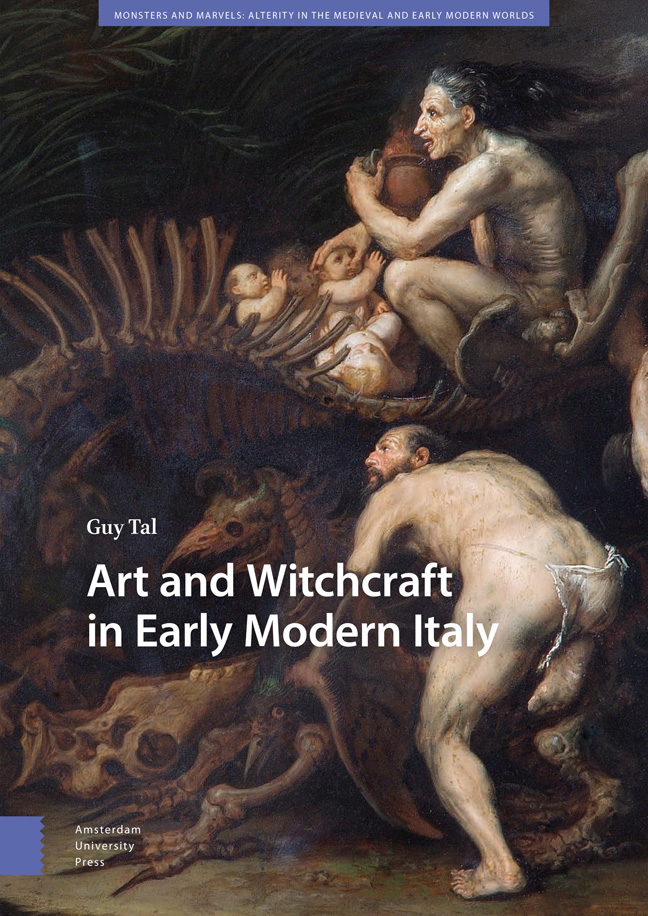Book contents
- Frontmatter
- Contents
- List of Illustrations
- Acknowledgments
- Introduction
- 1 Old Women under Investigation: The Drab Housewife and the Grotesque Hag
- 2 Chimerical Procession: The Poetics of Inversion and Monstrosity
- 3 Priapic Ride: Gigantic Genitals, Penile Theft, and Other Phallic Fantasies
- 4 Magical Metamorphoses: Variations on the Myths of Circe and Medea
- 5 A Visit from the Devil: Horror and Liminality in Caravaggesque Paintings
- Epilogue
- Bibliography
- Index
5 - A Visit from the Devil: Horror and Liminality in Caravaggesque Paintings
Published online by Cambridge University Press: 22 February 2024
- Frontmatter
- Contents
- List of Illustrations
- Acknowledgments
- Introduction
- 1 Old Women under Investigation: The Drab Housewife and the Grotesque Hag
- 2 Chimerical Procession: The Poetics of Inversion and Monstrosity
- 3 Priapic Ride: Gigantic Genitals, Penile Theft, and Other Phallic Fantasies
- 4 Magical Metamorphoses: Variations on the Myths of Circe and Medea
- 5 A Visit from the Devil: Horror and Liminality in Caravaggesque Paintings
- Epilogue
- Bibliography
- Index
Summary
Abstract: Four early seventeenth-century Roman paintings collectively forge a novel iconography that upturns the stereotype of the powerful and appalling witch. It presents the image of a horror-stricken witch (of either sex) fending off a pair of claws exscinded by the frame from the implied figure of the devil. Art historians have noted the distinctive Caravaggesque manner of these paintings, as well as the moralizing critique of the relationship between the Devil and his clientele. However, meager scholarly attention has been paid to the visceral and cerebral experience of viewing the paintings. This chapter argues that the image of the radically excised devil forms the emotional and intellectual crux of the paintings by intensifying the effect of horror and manifesting notions about demonic liminality.
Keywords: necromancy, Caravaggio, horror and terror, demon's corporeality, demonology
A youthful witch, depicted half-length, makes irresistible play for the viewer's attention, a dramatic expression of astonishment, fear, and disgust overspreading her features (fig. 82). Startled, abruptly, in the midst of enacting a magical ritual upon a human skull atop a bowl of live coals, and with an occult manual at her elbow, she turns towards the viewer her heavily contorted, flushed visage: the deeply furrowed brow, heavily knitted eyebrows, and wide-eyed grimace indicate a heightened psychological state. Her abrupt movement causes her breasts to spill out of her dress, which falls down to expose her shoulder as well. It takes a moment to identify the cause of her horror: a pair of long and articulated black claws irrupt into the pictorial space from the left.
This small canvas, hanging in the Pinacoteca Civica in Ancona, and a larger panel version, formerly owned by the Maurizio Canesso Gallery in Paris and now held in a private collection (fig. 83), have been attributed to the Roman painter Angelo Caroselli (1585–1652) or to an anonymous artist dubbed in recent decades “Pseudo-Caroselli.” Adaptations of this dramatic scene, in which a male magician replaces the female witch, were painted by Pietro Paolini from Lucca (1603–81; fig. 84) and by the Haarlem native Pieter van Laer (1599–ca.1642; fig. 85). The four paintings (in addition to two copies of Paolini's painting), collectively denoted here Witch Alarmed by a Devil given their cohesion as a group, introduce a unique iconography developed during the artists’ sojourns in Rome in the 1620s and 1630s.
- Type
- Chapter
- Information
- Art and Witchcraft in Early Modern Italy , pp. 253 - 316Publisher: Amsterdam University PressPrint publication year: 2023



